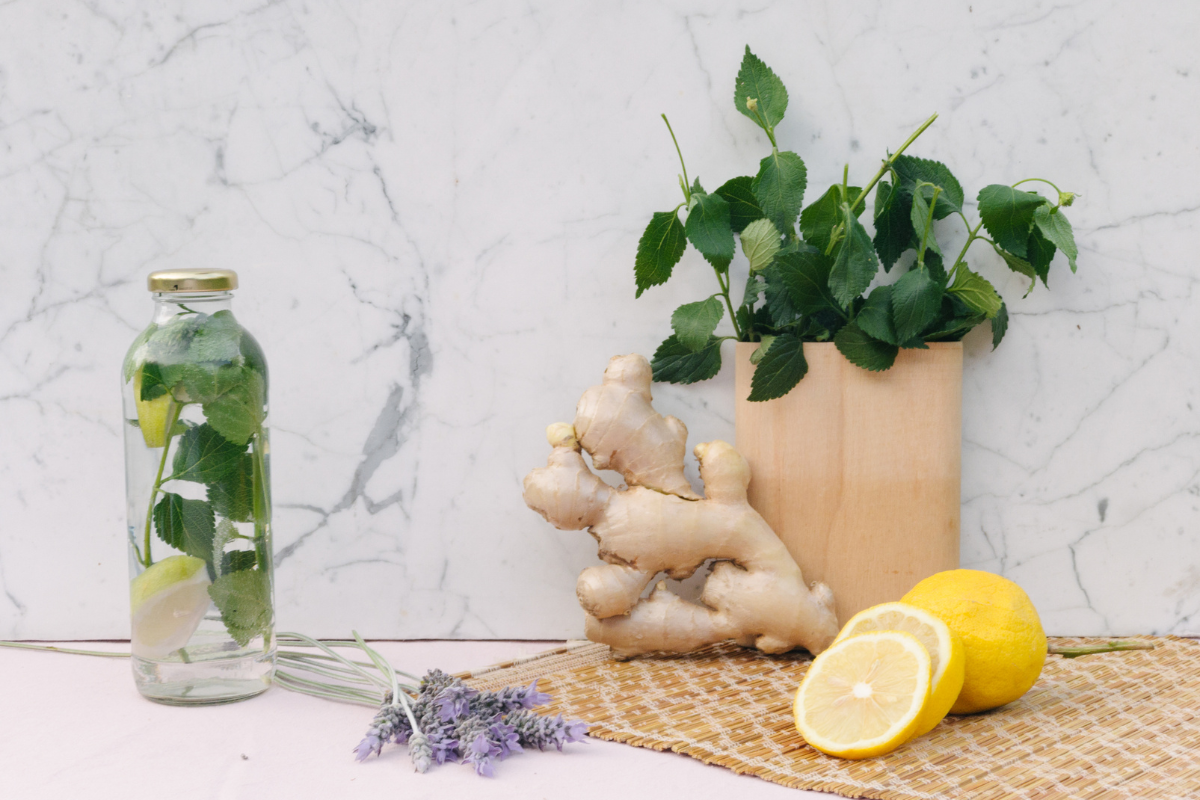It’s quite fascinating how we often circle back to the roots of tradition, especially when caring for our health. Think about it: long before the buzz of pharmacies and the rush of modern medicine, people had ways of dealing with aches, pains, and sniffles. Among these age-old solutions, traditional remedies using ginger and lavender have stood the test of time. These plants have been the unsung heroes in the backyards and kitchens of our ancestors, offering a gentle nudge to our bodies to mend and soothe themselves.
Isn’t it amazing how these natural wonders have been hanging around, just waiting to lend a hand? It’s like having a friendly neighbor who’s always there to help, no strings attached. And the best part? These remedies come with stories and experiences handed down through generations, like a treasured family recipe for wellness.
So, why don’t we stroll down this garden path of tradition? Let’s rediscover these natural gems, ginger and lavender, and maybe, just maybe, we’ll find some timeless wisdom in their whispers that can still make a difference in our fast-paced lives today.
Exploring the Historical Use of Ginger in Traditional Remedies
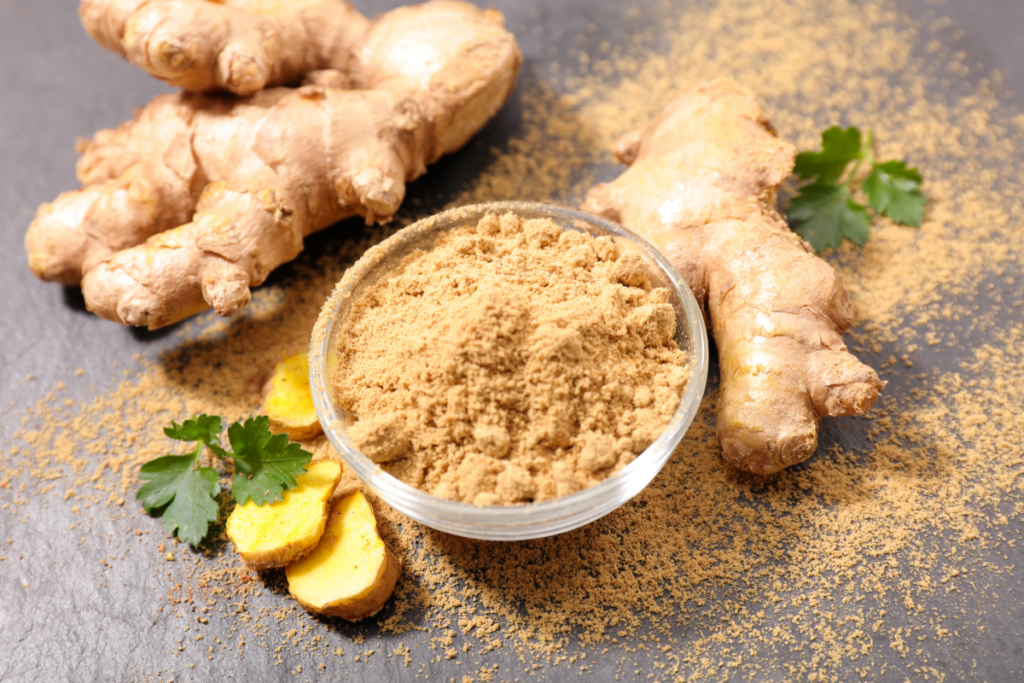
For centuries, people have been using ginger in traditional remedies across various cultures. In natural medicine, ginger has digestive, anti-inflammatory, and immune-boosting properties.
Ancient civilizations, including the Greeks, Romans, and Chinese, recognized the therapeutic properties of ginger and incorporated it into their medicinal practices. In Ayurvedic medicine, some use ginger to treat arthritis, improve digestion, and relieve respiratory issues. Traditional Indian medicine also utilizes ginger to treat nausea, headaches, and menstrual pain.
During the medieval period, ginger became a popular spice for culinary and medicinal purposes. We can use it to alleviate stomach ailments and aid digestion after hearty meals.
In modern times, ginger remains a powerful ingredient in natural medicine. Ginger reduces pain, inflammation, cholesterol, nausea and vomiting, according to research.
❣The Science Behind Ginger’s Healing Properties
Ginger’s medicinal properties come from gingerols and shogaols in its root. Gingerols have anti-inflammatory properties, helping to reduce pain and swelling in the body. Shogaols have been found to have anti-cancer properties and may also aid in digestion.
Ginger also contains antioxidants, which scavenge free radicals and protect the body from oxidative stress. It boosts health and lowers chronic illness risk.
With its rich history in traditional medicine and modern-day research supporting its therapeutic benefits, ginger is a potent ingredient to incorporate into your wellness routine.
Lavender: The Soothing Scent of Tradition
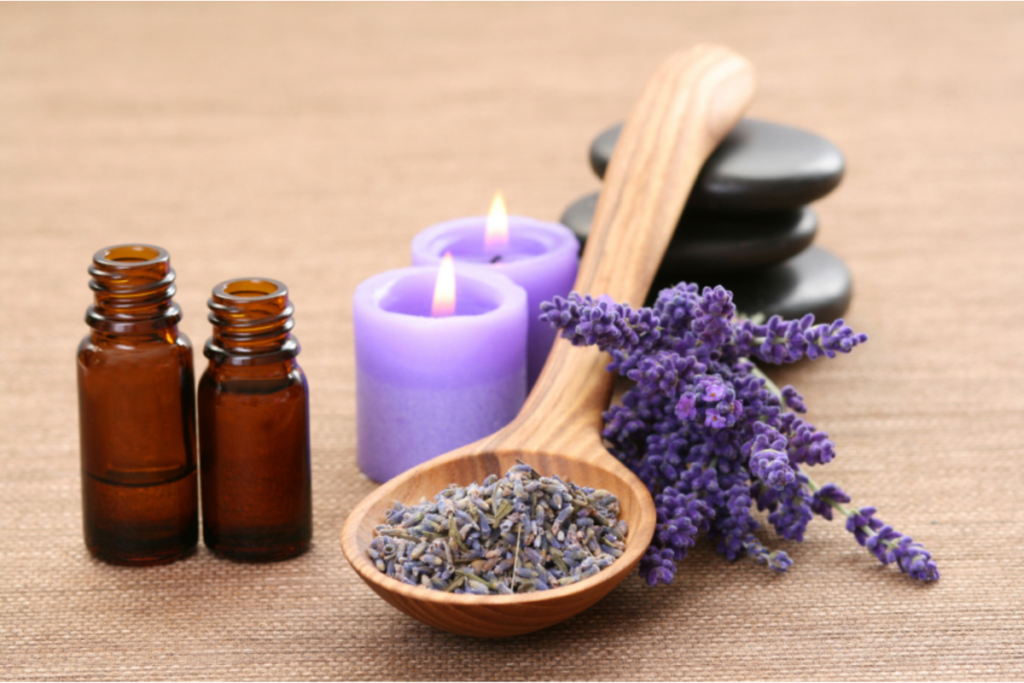
Lavender is a beloved botanical used for centuries in traditional remedies. Its soothing scent and numerous therapeutic properties make it a go-to for promoting relaxation, reducing anxiety, and improving sleep quality.
Historically, Egyptians used lavender for mummification and as a perfume. In ancient Greece and Rome, people used it for bathing, cooking, and as a natural remedy for various ailments. Fast forward to modern times, and the benefits of lavender are still being recognized and utilized.
Lavender is known for relaxing and reducing anxiety. Inhaling lavender essential oil reduces tension and anxiety, according to research. The calming effects of lavender also make it a beneficial aid for improving sleep quality, as it can help to soothe a racing mind and promote feelings of calmness.
Lavender also has benefits for the skin, including promoting healing and reducing inflammation. People have been using it to soothe burns, insect bites, and other irritations. Lavender oil administered topically reduces acne and improves skin look.
The Synergistic Effects of Ginger and Lavender
When it comes to natural remedies, ginger and lavender stand out for their impressive healing properties. Did you realize that mixing these two botanicals boosts their benefits?
Let’s explore the science behind ginger and lavender’s synergy and how to incorporate this powerful duo into your wellness routine.
💞How Ginger and Lavender Work Together
Synergy is the interaction of two or more elements that results in a combined effect greater than the sum of their individual effects. In the case of ginger and lavender, this means that the combination of these two botanicals can amplify their therapeutic properties and create a more potent remedy.
Gingerol, an antioxidant and anti-inflammatory ingredient, helps aid digestion, immunity, and inflammation. Lavender, on the other hand, is known for its calming and relaxing effects on the mind and body. When combined, ginger and lavender provide a holistic approach to wellness, addressing both physical and emotional concerns.
💞Ways to Experience the Synergistic Effects of Ginger and Lavender
- Ginger and Lavender Tea: Brew a cup of ginger tea and add a few drops of lavender essential oil for a relaxing and soothing beverage.
- Ginger and Lavender Bath: Add a few drops of ginger and lavender essential oil to your bath for a soothing and detoxifying soak.
- Ginger and Lavender Massage Oil: Lavender and ginger essential oils with coconut or almond oil produce a relaxing massage oil.
- Ginger and Lavender Aromatherapy: Blend ginger and lavender essential oils to relax and soothe tension and anxiety.
Sustaining Tradition: Ethical and Sustainable Harvesting
As you explore the world of traditional remedies and the benefits of botanicals like ginger and lavender, it’s important to consider the impact of sourcing these ingredients. Ethical and sustainable harvesting practices are crucial to protecting the environment, preserving biodiversity, and supporting local communities.
Many companies are now prioritizing sustainability in their sourcing and production methods. Choose “fair trade” or “organic” items to assure ecologically and socially responsible plant cultivation.
In addition to purchasing sustainably sourced products, you can consider growing your herbs at home. It guarantees fresh, high-quality ingredients and lowers transportation and packing carbon emissions.
DIY Remedies: Incorporating Ginger and Lavender into Your Routine
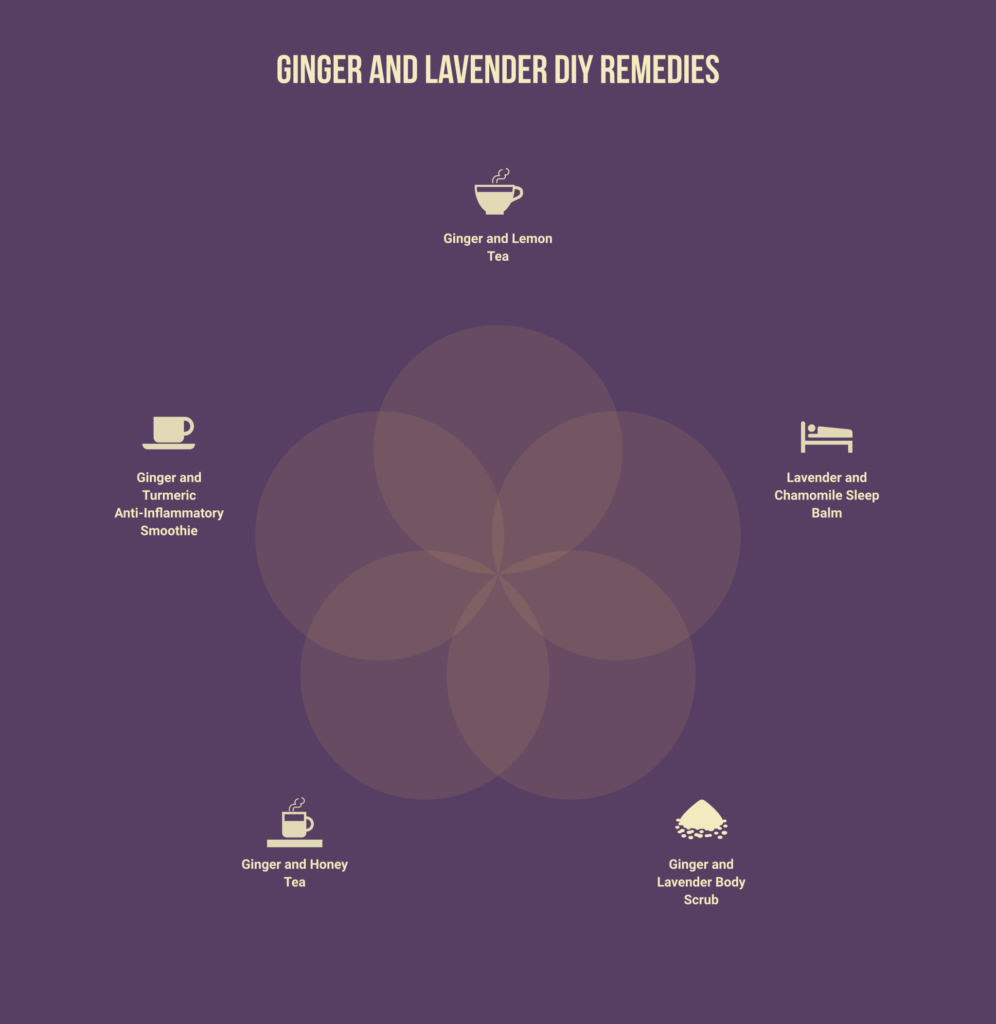
Want to improve your health naturally? Look no further than ginger and lavender! These botanical powerhouses have been used for centuries to address various health concerns, from inflammation and digestive issues to anxiety and skin irritation.
Here are some simple and effective DIY remedies to incorporate ginger and lavender into your daily routine:
✔Ginger and Lemon Tea
Feeling under the weather? Try this soothing and immune-boosting tea:
- Bring two cups of water to a boil in a saucepan.
- Add 1 inch of fresh ginger root, thinly sliced.
- Simmer for 10-15 minutes until the water turns golden and fragrant.
- Strain the ginger slices and pour the tea into a mug.
- Add the juice of half a lemon and a drizzle of honey to taste.
Enjoy your warm and refreshing tea, and feel your symptoms fade away!
✔Lavender and Chamomile Sleep Balm
Having trouble falling asleep? This nourishing and relaxing balm will help you drift off into dreamland:
- Double-boil 1/4 cup beeswax and 1/2 cup coconut oil.
- Put 5 to 10 drops of chamomile essential oil and 10 to 15 drops of lavender essential oil.
- Pour the mixture into a small tin jar and let it cool and solidify.
- Apply a small amount of the balm to your temples, wrists, and chest before bedtime.
Feel the tension melt away, and enjoy a peaceful and restorative sleep!
✔Ginger and Lavender Body Scrub
Want to pamper your skin and stimulate circulation? This invigorating and exfoliating scrub will do the trick:
- Combine one cup of brown sugar with half a cup of coconut oil.
- Add 1 tablespoon of fresh ginger root, grated, and 10-15 drops of lavender essential oil.
- Concentrate on rough regions like elbows and knees as gently massage the mixture into your skin.
- Warm water, rinse, and dry.
Feel your skin glow, and your senses awaken!
✔Ginger and Honey Tea
- Bring water to a boil.
- Add fresh ginger slices (about an inch) and let it simmer for 5-10 minutes.
- Take the pan off the heat and add honey to your liking.
- Enjoy the soothing and immune-boosting benefits of this delicious tea.
✔Ginger and Turmeric Anti-Inflammatory Smoothie
- Mix well. 1 cup of frozen pineapple, 1 banana, 1 tablespoon of grated ginger, 1 teaspoon of grated turmeric, and 1 cup of coconut milk are the ingredients that should be combined to make this smoothie.
- Enjoy a refreshing and anti-inflammatory smoothie that also boosts your immune system.
These are just a few of the many ways you can incorporate ginger and lavender into your life. Experiment and create the DIY remedies that work best for you!
Additional DIY Remedies using Ginger and Lavender
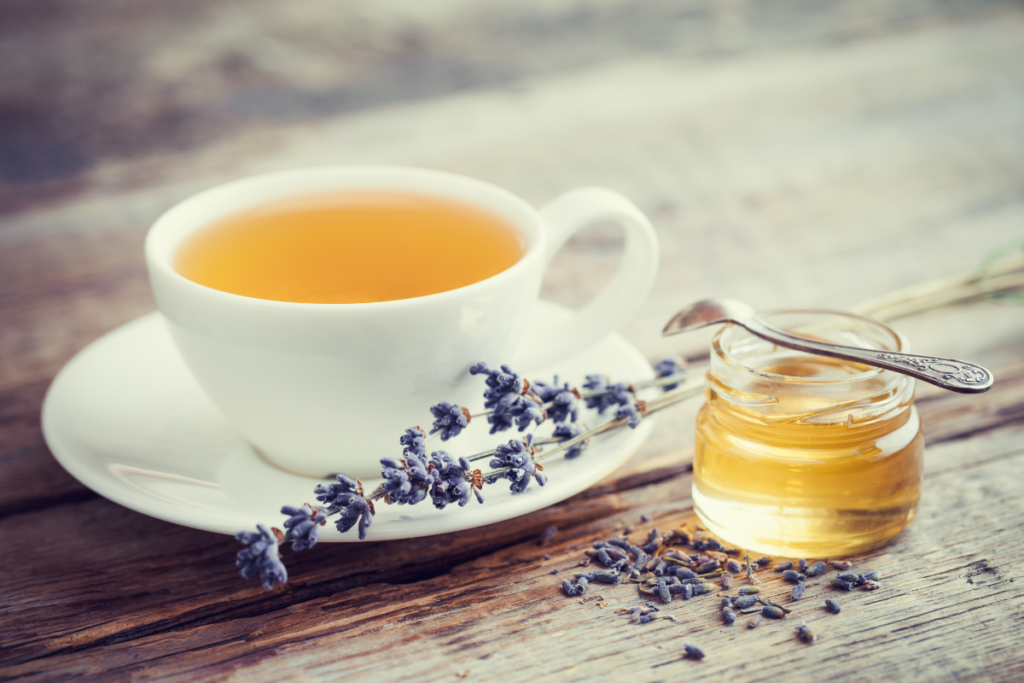
Expanding on the DIY remedies mentioned earlier, here are a few additional ways to incorporate ginger and lavender into your routine:
- Ginger-Lavender Bath Soak: Add a few drops of lavender essential oil and grated ginger to your bath for a relaxing and detoxifying soak.
- Lavender-Ginger Tea: Brew fresh ginger and lavender tea for a soothing cuppa that aids digestion, reduces inflammation, and promotes sleep.
- Ginger-Lavender Massage Oil: Combine equal parts ginger and lavender essential oils with a carrier oil like coconut or almond oil for a rejuvenating and calming massage oil.
Additional Traditional Remedies with Ginger and Lavender
Aside from the remedies mentioned earlier, there are numerous other ways to incorporate ginger and lavender into your wellness routine. You can easily make ginger and lavender-infused oils, balms, and salves by following simple DIY online recipes. You can use these homemade remedies for muscle pain relief, skin care, and aromatherapy.
- Ginger and lavender tea is a tasty and soothing beverage that can help with digestion, stress relief, and relaxation.
- Adding ginger and lavender to your bathwater will create a relaxing and calming experience that can help soothe sore muscles and joints.
- A ginger and lavender foot soak can help improve circulation, relieve foot pain, and promote relaxation.
- Ginger and lavender inhalation therapy is a great way to alleviate respiratory issues and sinus congestion. Simply breathe in the steam from a pot of boiling water infused with ginger and lavender essential oils.
Remember to always choose high-quality, organic ginger and lavender to ensure maximum therapeutic benefits and to support ethical and sustainable harvesting practices.
Frequently Asked Questions
Q: What is a traditional herbal remedy?
A: A traditional herbal remedy treats various ailments that use plants and their parts, like leaves, roots, flowers, and seeds. These remedies are based on knowledge and practices passed down through generations, often forming an integral part of cultural heritage and folk medicine. Unlike modern pharmaceuticals, traditional herbal remedies rely on natural ingredients and have been used for centuries to promote health and well-being.
Q: How is lavender used in different cultures?
A: In different cultures, lavender is celebrated for its soothing fragrance and therapeutic properties. In France, it’s a staple in perfumes and sachets, while in the Mediterranean, it’s often used in cooking, lending a floral touch to dishes. Traditional English gardens feature lavender for its beauty and scent, and it’s also used in teas to promote relaxation. In the United States, lavender is popular in aromatherapy and natural health products for stress relief and sleep aid. Across cultures, lavender’s versatility in culinary, cosmetic, and medicinal uses showcases its global appeal.
Q: What happens if I drink ginger water every day?
A: If you drink ginger water daily, you may experience various health benefits due to ginger’s anti-inflammatory and antioxidant properties. It can aid digestion, reduce nausea, and even help fight the common cold. However, as with any remedy, moderation is key, and excessive intake can lead to discomfort like heartburn or upset stomach. It’s always a good idea to consult with a healthcare professional, especially if you have any medical conditions or are taking other medications.
Q: What are the side effects of too much ginger?
A: Eating too much ginger, you might get heartburn, gas, stomachaches, and a burning feeling in your mouth. Additionally, excessive ginger intake might thin the blood, which could be problematic for people on blood thinners or those with bleeding disorders. Always enjoy ginger in moderation and consult a healthcare provider if you have concerns or pre-existing health conditions.
Q: Why is lavender so relaxing?
A: Lavender is so relaxing primarily because of its natural compounds that have a soothing effect on the nervous system. The scent of lavender oil, in particular, has been shown to lower heart rate, blood pressure, and stress levels, which can lead to a state of relaxation. These calming properties make lavender a popular choice in aromatherapy for promoting sleep, reducing anxiety, and creating a peaceful environment.
Conclusion
You’ve taken the first step toward using traditional treatments for your health by adding ginger and lavender to your routine. We hope this article has shed light on the historical use of these botanicals and their powerful benefits for natural health and well-being. By utilizing the synergistic effects of ginger and lavender and embracing sustainable and ethical harvesting practices, you can unlock the potential of these ancient remedies.
Remember, there are many DIY remedies you can create at home, from teas and tinctures to skincare products and natural remedies that incorporate ginger and lavender. Start small and gradually incorporate these botanicals into your daily life to experience their full potential.

